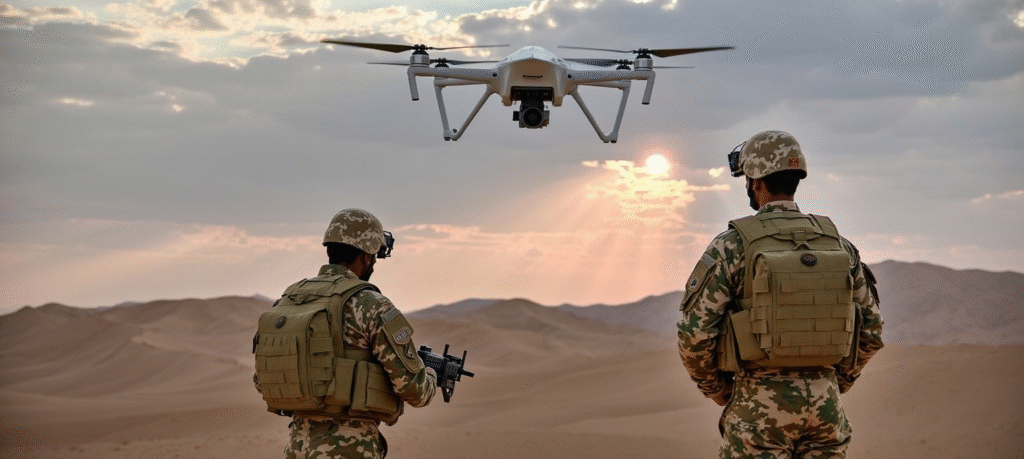Since 2020, Burundi has taken notable steps to modernize its border surveillance efforts through the adoption of small unmanned aerial vehicles (UAVs), commonly referred to as drones. In response to increasing regional instability and security threats along its borders, especially with the Democratic Republic of Congo (DRC) and Rwanda, the Burundian government has turned to cost-effective and mobile aerial surveillance platforms to monitor border zones, detect illicit activity, and enhance situational awareness in remote or inaccessible areas.

Why Drones Became Necessary
Burundi’s western and northern borders have historically been porous, often challenged by smuggling, armed group incursions, and illegal crossings. Since 2020, a rise in transnational threats—including weapons trafficking and rebel movement from eastern DRC—has compelled Burundian authorities to reinforce surveillance along vulnerable stretches of its territory.- These threats have been compounded by dense terrain, poor infrastructure, and logistical limitations, all of which hinder rapid deployment of personnel and equipment. Traditional security patrols on foot or vehicle are not only slow but also pose significant risks to officers operating in contested or unpredictable areas. In this context, drones emerged as a practical alternative that could fill surveillance gaps without putting personnel at risk.
Drones deployed and Their Capabilities

- Burundi’s drone program has focused primarily on compact, commercially available UAVs with surveillance-grade capabilities. These include quadcopters and fixed-wing drones outfitted with high-resolution cameras, thermal imaging sensors, and GPS-enabled navigation. Some models have flight durations of up to 90 minutes and can operate within a 10-15 kilometer range, allowing operators to cover vast stretches of border terrain in a single mission.
- While these drones do not carry weapons or offensive capabilities, they are equipped to perform a range of critical tasks. These include:
- Day and night surveillance using optical and infrared sensors
- Live video feeds to command centers or mobile units
- Mapping and terrain analysis for border infrastructure planning
- Tracking movements of suspicious groups or individuals
- Security forces have been trained to operate these systems from ground control stations, often housed in mobile vehicles or border posts. The ability to launch, monitor, and recover drones with minimal infrastructure has proven essential in rural areas where airstrips or permanent facilities are unavailable.
Training and Operational Integration
- To ensure effective integration of drones into border security operations, Burundi has partnered with international security consultants and regional allies. Through workshops, technical exchanges, and joint exercises, Burundian personnel have been trained in drone piloting, data interpretation, maintenance, and cybersecurity protocols.
- Much of the training has emphasized coordination between aerial surveillance units and ground patrols. Once a drone identifies suspicious activity—such as unmarked crossings, armed groups, or smuggling convoys—it relays information to ground units, which can then respond quickly and with greater situational awareness.
- This layered approach has improved the responsiveness of border security forces and has reduced the likelihood of ambushes, miscommunication, or resource misallocation during operations.
Challenges in Implementation
- Despite the advantages, the drone program has faced several challenges. Maintaining equipment in Burundi’s often humid and unpredictable climate has proven difficult, particularly when drones are exposed to dust, rain, or extreme temperatures. Battery life and signal interference in mountainous terrain also limit operational endurance.
- Another concern is the need for consistent funding. While small drones are relatively inexpensive compared to manned aircraft, the program still requires a steady supply of replacement parts, software updates, and operator training to remain effective.
- Legal and privacy frameworks are still being developed to regulate drone use in a way that respects civil liberties and avoids misuse. Ensuring that surveillance is confined to national security purposes remains a priority, especially as public interest in drone technology grows across other sectors like agriculture and disaster response.
Strategic and Regional Implications
- Burundi’s adoption of drones not only improves national security but also aligns with broader regional trends. East African countries like Rwanda, Kenya, and Uganda have similarly embraced drone technology for defense, surveillance, and humanitarian missions. Burundi’s efforts signal a desire to modernize and professionalize its security apparatus while keeping pace with neighbors and regional partners.
- The enhanced border monitoring capacity may also contribute to better cooperation with regional mechanisms such as the East African Standby Force (EASF) and the African Union Border Programme. With more reliable surveillance data, Burundi is better positioned to share intelligence, track cross-border threats, and support collective security efforts.
Looking Ahead
Burundi’s use of small surveillance drones is expected to grow in the coming years as more resources are allocated to national security modernization. The government has expressed interest in expanding drone coverage to other sectors, including wildlife protection, emergency response, and infrastructure monitoring.
As Burundi refines its drone strategy, continued investment in training, maintenance, and regional collaboration will be key to maximizing the impact of this technology. In a region where agility and adaptability are essential for peace and stability, drones offer a powerful new tool for safeguarding borders and enhancing national resilience.


